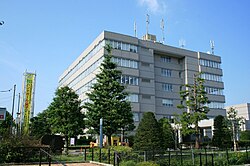Wakō, Saitama
Wakō
和光市 | |
|---|---|
 Wakō City Hall | |
 Location of Wakō in Saitama Prefecture | |
| Coordinates: 35°46′52.4″N 139°36′20.5″E / 35.781222°N 139.605694°E | |
| Country | Japan |
| Region | Kantō |
| Prefecture | Saitama Prefecture |
| Area | |
| • Total | 11.04 km2 (4.26 sq mi) |
| Population (February 2016) | |
| • Total | 80,666 |
| • Density | 7,310/km2 (18,900/sq mi) |
| Time zone | UTC+9 (Japan Standard Time) |
| - Tree | Ginkgo biloba |
| - Flower | Satsuki azalea |
| Phone number | 048-464-1111 |
| Address | 1-5 Hirosawa, Wako-shi, Saitama-ken 351-0192 |
| Website | http://www.city.wako.lg.jp/ |
Wakō (和光市, Wakō-shi) is a city located in Saitama Prefecture, Japan. As of 1 February 2016[update], the city had an estimated population of 80,666, and a population density of 7310 persons per km². Its total area is 11.04 square kilometres (4.26 sq mi).
Geography
Located in southern Saitama Prefecture bordering on Tokyo, Wakō is within easy commuting distance from downtown Tokyo.
Surrounding municipalities
History
Archaeological examination of several sites around Wakō has revealed the remains of a number of villages in the area, including a large amount of Jōmon period pottery, stone tools and other remains. Signs of early rice cultivation coinciding with the Yayoi period as well as quantities of Yayoi period pottery and implements have also been found.
The area of modern Wakō developed from the Muromachi period as Shirako-juku, a post station on the Kawagoe-kaidō highway.
The villages of Shirako and Niikura were created within Niikura District, Saitama with the establishment of the municipalities system on April 1, 1889. Niikura District was abolished in 1894, becoming part of Kitaadachi District. The two villages were merged on April 1, 1943, becoming the town of Yamato. Yamato was elevated to city status on October 31, 1970 and was renamed Wakō.
Economy
Wakō was formerly home to a Honda factory, but is now the location for the company's technical development section. Part of the headquarters function of Honda is scheduled to move from Tokyo. The head offices of RIKEN, a large natural sciences research institute in Japan, are also located in the city. The city also serves as a bedroom community for Tokyo.
Education
Wakō has eight elementary schools, three middle schools and two high schools, as well as two special education schools.
Transportation
Railway
Highway
Sister city relation
 Longview, Washington, United States, since October 1, 1999[1]
Longview, Washington, United States, since October 1, 1999[1]
Local attractions Wakō
Myoten-ji
This temple was consecrated by Sudagoro Tokimitsu, the local administrator of Shimoniikura (1278–1287). A statue of Nichiren and a wooden plaque with the inscription: "Namu myoho rengekyo" reside in the temple. They are important treasures of Wakō city.
Koyasu no Shimizu (Temple for Safe Childbirth)
Per local legend, Nichiren called at the house of his old friend, Tokimitsu while on his way to exile in Sado. Tokimitsu's wife was going through a difficult childbirth. When Nichiren prayed for a safe delivery and made a blessing with a willow twig a spring of pure water sprang up on the spot. Nichiren then had Tokimitu's wife hold the willow twig while water from the spring was poured into her mouth whereupon she soon gave birth to a healthy baby boy. There used to be a large willow tree beside the pond at the temple, and it is said that this tree grew from the twig that Nichiren used to bless the birth. The tree is no longer there today.
Kawagoe Kaidō
The Kawagoe Kaidō was a highway completed in 1633 when the third shōgun Tokugawa Iemitsu visited Kawagoe Senpa Tōshōgū (Shinto shrine). At that time, Kawagoe Castle played an important role in governing the northern part of Musashi Province. Kawagoe was 10 Ri (about 40 kilometres (25 mi)) from Nihonbashi in the old part of Edo and there were six shukuba along the way, namely: Kamiitabashi, Shimonerima, Shirako, Hizaori, Ōwada, and Ōi. These post stations were officially regulated settlements catering to travelers. Shirako-juku was 20 kilometres (12 mi) from Edo and travelers often stopped there for lunch. After a steep winding hill and with ample spring water, Shirako-juku was a good rest stop. Travelers came from the direction of Nittazaka then went up O-saka and down Kurayami-zaka, which was dark even in the daytime.
Choshōji (Temple of the Shingon Sect)
The origin of this Shingon sect temple pre-dates the Edo period. The temple was dedicated to the Juichimen Kannon (Kannon with eleven faces). The wooden statue may have been made at the beginning of the Edo period. There is a huge Ginkgo tree in the temple grounds. The tree is estimated to be over 700 years old, has a diameter of more than 7.5 meters and stands nearly 30 meters tall. It is designated as a natural monument of the Wako City.
Ikkan-ji , Gorintō Pagoda
Ikkan-ji is a Sōtō sect temple built during the Kan'ei era (1624–43) and was consecrated by Sakai Tadashige, a local administrator of Shimoniikura in the Edo period. It served as the family temple of the Sakai clan. Gorintō, or stone five level pagodas were placed at graves as a memorial and to console the spirits of the departed. Three gorinto can be found at Ikkan-ji at the graves of Tadashige Sakai, his wife, and a former administrator's wife.
Noted people from Wako
- Keisuke Kato, actor
- Toshio Kayama, politician


